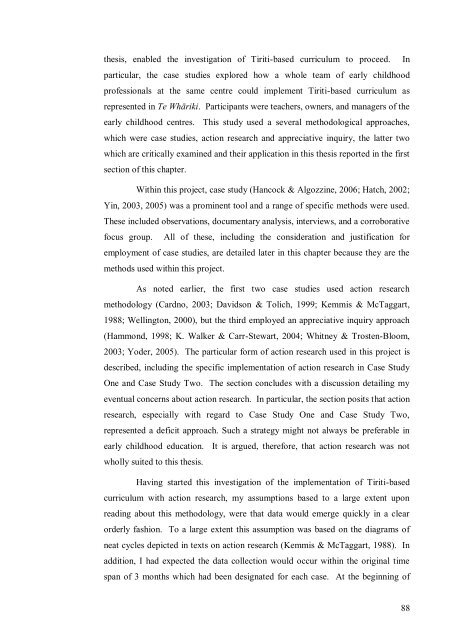supporting tiriti-based curriculum delivery in mainstream early ...
supporting tiriti-based curriculum delivery in mainstream early ...
supporting tiriti-based curriculum delivery in mainstream early ...
You also want an ePaper? Increase the reach of your titles
YUMPU automatically turns print PDFs into web optimized ePapers that Google loves.
thesis, enabled the <strong>in</strong>vestigation of Tiriti-<strong>based</strong> <strong>curriculum</strong> to proceed. In<br />
particular, the case studies explored how a whole team of <strong>early</strong> childhood<br />
professionals at the same centre could implement Tiriti-<strong>based</strong> <strong>curriculum</strong> as<br />
represented <strong>in</strong> Te Whāriki. Participants were teachers, owners, and managers of the<br />
<strong>early</strong> childhood centres. This study used a several methodological approaches,<br />
which were case studies, action research and appreciative <strong>in</strong>quiry, the latter two<br />
which are critically exam<strong>in</strong>ed and their application <strong>in</strong> this thesis reported <strong>in</strong> the first<br />
section of this chapter.<br />
With<strong>in</strong> this project, case study (Hancock & Algozz<strong>in</strong>e, 2006; Hatch, 2002;<br />
Y<strong>in</strong>, 2003, 2005) was a prom<strong>in</strong>ent tool and a range of specific methods were used.<br />
These <strong>in</strong>cluded observations, documentary analysis, <strong>in</strong>terviews, and a corroborative<br />
focus group. All of these, <strong>in</strong>clud<strong>in</strong>g the consideration and justification for<br />
employment of case studies, are detailed later <strong>in</strong> this chapter because they are the<br />
methods used with<strong>in</strong> this project.<br />
As noted earlier, the first two case studies used action research<br />
methodology (Cardno, 2003; Davidson & Tolich, 1999; Kemmis & McTaggart,<br />
1988; Well<strong>in</strong>gton, 2000), but the third employed an appreciative <strong>in</strong>quiry approach<br />
(Hammond, 1998; K. Walker & Carr-Stewart, 2004; Whitney & Trosten-Bloom,<br />
2003; Yoder, 2005). The particular form of action research used <strong>in</strong> this project is<br />
described, <strong>in</strong>clud<strong>in</strong>g the specific implementation of action research <strong>in</strong> Case Study<br />
One and Case Study Two. The section concludes with a discussion detail<strong>in</strong>g my<br />
eventual concerns about action research. In particular, the section posits that action<br />
research, especially with regard to Case Study One and Case Study Two,<br />
represented a deficit approach. Such a strategy might not always be preferable <strong>in</strong><br />
<strong>early</strong> childhood education. It is argued, therefore, that action research was not<br />
wholly suited to this thesis.<br />
Hav<strong>in</strong>g started this <strong>in</strong>vestigation of the implementation of Tiriti-<strong>based</strong><br />
<strong>curriculum</strong> with action research, my assumptions <strong>based</strong> to a large extent upon<br />
read<strong>in</strong>g about this methodology, were that data would emerge quickly <strong>in</strong> a clear<br />
orderly fashion. To a large extent this assumption was <strong>based</strong> on the diagrams of<br />
neat cycles depicted <strong>in</strong> texts on action research (Kemmis & McTaggart, 1988). In<br />
addition, I had expected the data collection would occur with<strong>in</strong> the orig<strong>in</strong>al time<br />
span of 3 months which had been designated for each case. At the beg<strong>in</strong>n<strong>in</strong>g of<br />
88
















